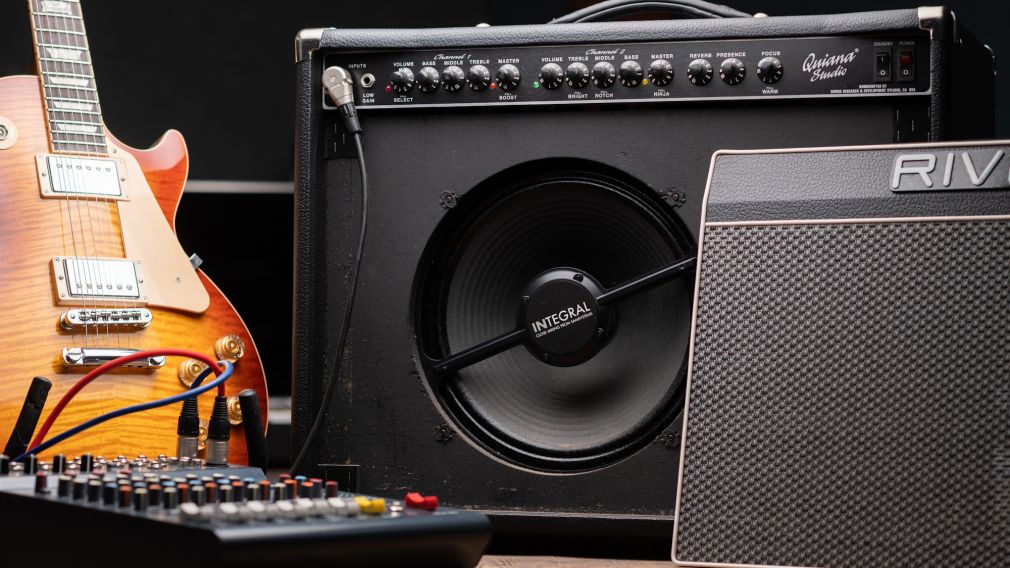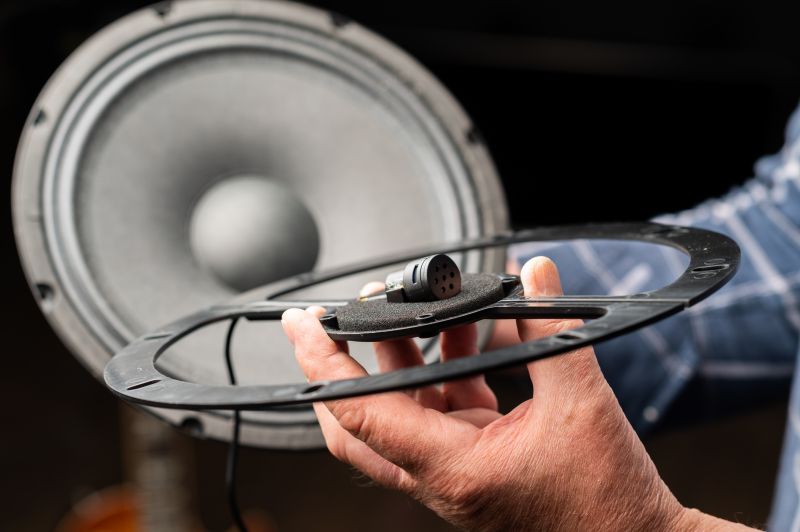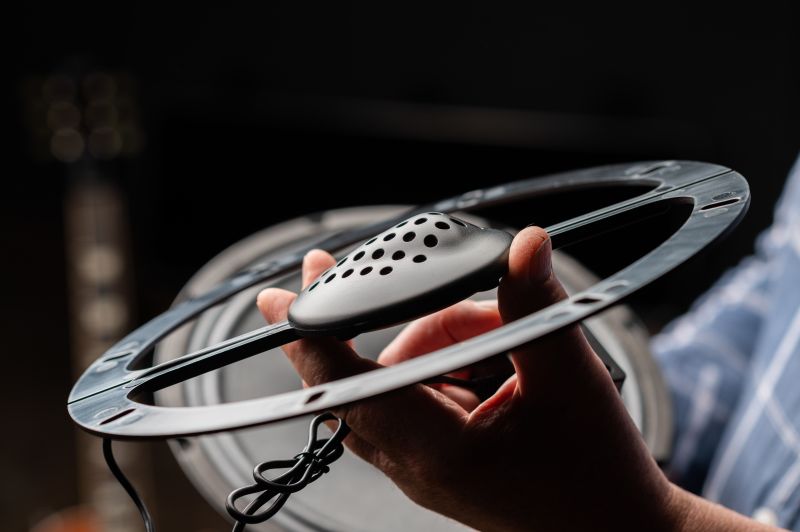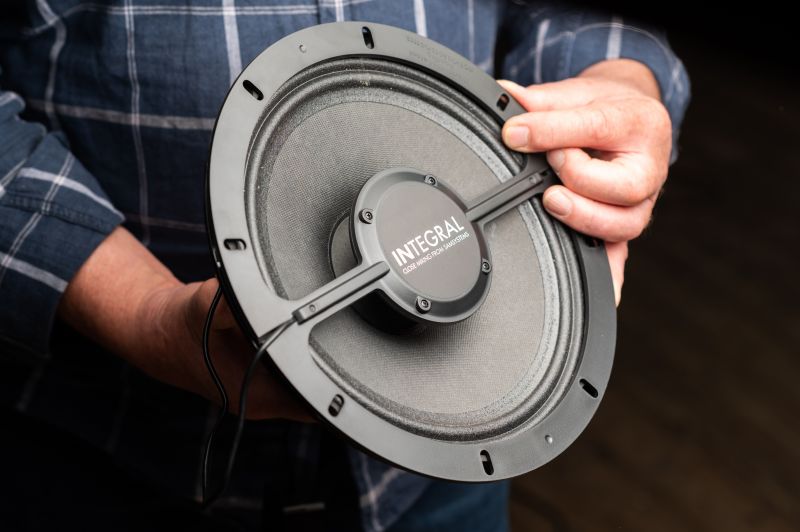Integral Offers an Alternative to Traditional Close Miking Techniques

Samsystems, established in 2012, is the UK-based “inventors and manufacturers of the world’s first integral close miking system for guitar amplifiers and speaker cabinets.” The company's new Integral IM10 – IM12 provides an alternative concept to close cab miking as it fits on the speaker inside any speaker cabinet.
360degs questions? Visit www.integral.uk.com/FAQs for answers.
First, a little about close miking. Close miking is the practice of putting a microphone close, typically less than a foot away from the source of the sound to capture more direct sound and to limit the amount of ambient noise. The practice is often utilized when recording several separate instruments while keeping the signals separate, or when trying to prevent interference during an amplified performance. An example of close-miking can be heard in The Beatles “Eleanor Rigby” when sound engineer Geoff Emerick close miked the string quartet at the request of Paul McCartney.
Debuting at the 2018 NAMM Show, The Integral IM Series “removes the vulnerabilities associated with external close miking of guitar cabs and combos.” With the ability to be installed in minutes, both the Integral IM10 and IM12 are a “rigid frame mounted internally between the cabinet grill and existing speaker. A high-quality, super cardioid dynamic microphone with an exceptionally high/low, full-range frequency response, pressure tested at extreme volumes, is housed within the central ‘pepper pot’ strategically aimed off-center of the speaker coil, delivering the true, balanced ‘ANALOGUE’ output from the speaker via an XLR connector to the mixing desk and onward to the monitors or FOH PA.”
We sat down with Richard Smith, Sam Systems` designer of Integral, to learn about this revolutionary product.
What was the inspiration for the Integral?
I play amplified harmonicas and not only had issues hearing myself in the foldback monitors but also grew tired of lengthy setup and soundcheck times. I quickly realized that I wasn’t the only one who suffered from these frustrations but it was an issue all my guitar playing buddies and front of house engineers (who usually get the blame if players aren’t happy with their sound) faced. I knew there had to be an easier, simpler, and quicker way of getting around the issues.
The Integral appears to have solved problems associated with the practice of close-miking, have you seen different segments of the industry (media, musicians, engineers) be receptive to this new technology?
That`s a good question and maybe it is worthwhile just listing some of the issues that the Integral has solved;
overspill and separation
soundcheck and mic positioning time especially in some cases there is no time for soundchecks, especially at festivals with the quick turnaround between bands
SPL levels
microphones on stands in front of cabs taking up space (not to mention additional shipping hassle)
the ease with which the setup is changed/ruined if the mic is knocked out of position; clutter on stage and mics being stolen while being packed up after a performance
Once installed, Integral consistently covers all those bases because it is always in the same place in front of the speaker, out of sight behind the fabric of the front cover, gig after gig.
We had different reactions from the various segments of the industry. From the media, we had great reviews as the concept was grasped pretty quickly and we were delighted when Guitarist magazine voted us “Gear of the Year” in their innovation section and Guitar International said it was “genius.” Musicians who know and use Integral, swear by it. Engineers have been the hardest area to crack. Sound is a very subjective issue and folks have a particular way of doing things or, they have a favorite mic, not necessarily because one brand is better than another but more because they know from experience what to do with it on the desk concerning setting the E.Q. Being the new kid on the block has been a challenge but once the concept is explained and demonstrated, the penny drops. If I`d had a buck for every time someone had asked why no one has done this before, I`d be a wealthy man.
What challenges have you overcome with the Integral?
The initial concept was to use the miniature condenser microphone capsules I`d worked with on a harmonica project with my friends at AKG, and which I still use to this day. The idea was to be able to move the position of the capsule between the edge of a speaker and the center of the cone to a position an engineer would consider the ‘sweet spot.’ Bits of electrical conduit and superglue were used, and we had instant gratification from the first working models. This led to waterjet-created mounting rings to match speaker sizes and so on. All seemed to go well during trials until our test sound engineer reported difficulties removing interference on the desk from the mics clipping once the volumes started to increase. Several old cell phones were dismantled to see how those guys had dealt with the issue with even smaller mic capsules. No matter the orientation, these little capsules just could not take being subjected to the high SPL [sound pressure level].
I moved on to a dynamic capsule, but of course, this was a major rethink because it was no longer possible to move the capsule from the center to the edge of the speaker without fouling the cone movement, and dynamic capsules were just not available in miniature sizes. Eventually, we did source a suitable capsule and it is mounted at the center of the speaker. Before anyone shouts it`s in the wrong place, please look at how we have orientated and housed the capsule. The first clue is in the mic cover, which has a teardrop shape to it. The teardrop shape allows for the capsule to lay on its side but be aimed towards the edge of the speaker cone.
How long did it take to get from conception to production?
There have been a few forks in the road and like all simple ideas, getting into production wasn`t quite as straight forward as one would expect. We spent the best part of four years road testing in the USA and Europe finding out that the fork in the road could be a dead end. You would think that four years is a long time and you`d be right. However, tooling up to go into production is a costly exercise and you can`t afford to commit to it without having the confidence that you`ve got the product right. Modifying injection mold tooling is to be avoided at all costs and with this in mind, in the latter stages of our testing, we were running with 3D printed versions, which were quick and easy to make final tweaks to with a revised CAD drawing, not cheap but cost-effective.

The second clue is the actual cover itself; it is a dome with a ‘pepperpot’ configuration. We have utilized the function of a sonic diffuser in the design of the cover and this has the effect of dissipating the harsh frequencies emanating from the center of the speaker. The mic then collects the diffused sound picked up after it has been mixed with all the other frequencies within the speaker cone.
We were also mindful of the clipping issue with the little condensers and needed to ensure we didn’t carry over the problem to the new capsules. A trip to the factory of a well-known amp company put Integral through its paces. We have no idea what SPL our mics can stand for one simple reason, we couldn`t get any louder in the test, we ran out of fader on the desk. A second test was done with an industry workhorse setup in the next channel. Integral went fader for fader and kept going long after the competition started clipping.
How has exhibiting at The NAMM Shows benefited the company?
Exhibiting at The NAMM Show has been crucial for us. The very nature of the product being hidden once installed gives rise to the question as to how you create industry awareness. Without the ability to demonstrate Integral, we would struggle. Having the facility to let a player try out the product means that the penny drops much quicker. Of course, selling the product worldwide needs local assistance, and attending the NAMM Shows, both in Anaheim and Nashville, has been a key part of our exposure strategy. Out of that has come some great relationships and we could not have achieved that without being there. After The 2020 NAMM Show, we now have a great partnership with RBI Music out of Texas who handles our US distribution. Rick Taylor, their product manager, is particularly adept with Integral as he also has firsthand experience of using it himself in his band. I can`t think of a better person to talk to about a product than a gigging musician using it. It couldn`t have happened without NAMM.
Are there any updates on the horizon for the Integral?
Whilst the 12” speaker is the guitarist`s go-to size, we have also had some success with the 10” for bass players where it has stood up to even the harshest treatment from the heavy rock end of the business. We have developed and road-tested an 8” successfully and are looking at potential sales for that size but for now, it is available as a 3D printed unit. Bearing in mind that Integral deliberately captures only the speaker sound and nothing else, we are looking at studio variations. Integral works well already in the studio and is well suited to be blended with a second mic to capture more room sound for that ambient feel.
Of course, you never know what lies ahead but I often think of Dolby and Intel. Wouldn`t it be cool if OEMs installed Integral at the factory? Just that little label saying it was onboard and saving the future owner hassle at gigs. Now, there`s a challenge!
Will you be at The 2021 NAMM Show?
We wouldn’t miss it!
For more information about the Integral, please visit them at https://www.integral.uk.com/.

